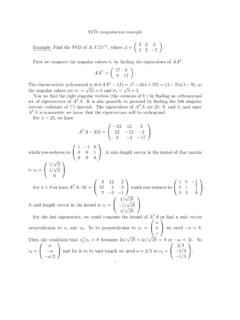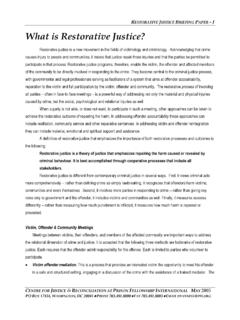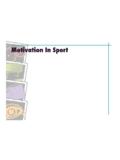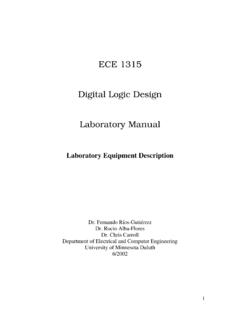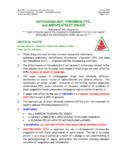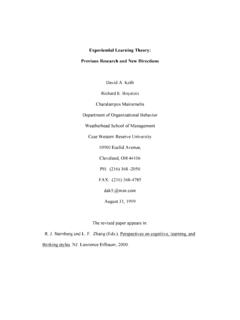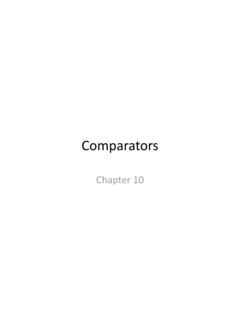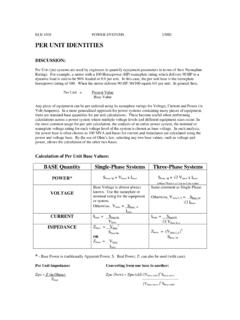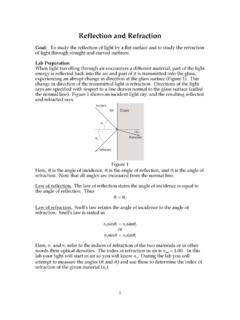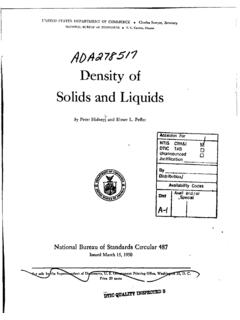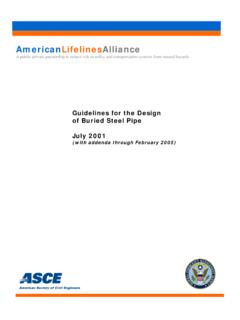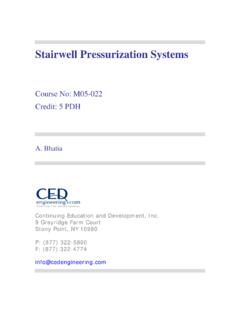Transcription of Chapter 12 Fluid Mechanics - University of Minnesota …
1 Chapter 12 Fluid DensityWe have already seen ( )thatthelocal destinyof a material can bedefined as =dmdV.( )When the object has uniform ( position independent) density, then thelocal density is the same asaverage densitydefined as =mV.( )For the same substance this number does not change even if the mass andvolume might be different. For example both a steel wrench and a steel nailhave the same density which the density of 12. Fluid MECHANICS166In SI the units of density are given by kilogram per cubic meter1kg/m3=1kg1m3( )but gram per unit centimeter are also widely used1g/cm3=1000kg/m3.
2 ( )In the following table we summarize densities of common substances: Chapter 12. Fluid MECHANICS167 Another useful (but dimensionless) measure of density isspecific den-sityalso known asrelative density. It is defined as a ratio of density of agiven substance to density of water (at temperature C),specific density = substance water.( )Example the mass and weight of the air (at1atm and20 C)in a living room ,andthemassand weight of an equal volume of of the living room isV= = 60 m3( )From definition of densitymair= airV=( kg/m3)(60 m3)=72kgmwater= waterV=(1000 kg/m3)(60 m3)= 104kg ( )and thus the corresponding weights arewair=mairg=(72kg)( )=700 Nwwater=mwaterg=( 104kg)( )= 105N.
3 ( ) the following objects in order from highest to lowestaverage density:(i) , 10 3m3;(ii) , 10 3m3;(iii) , 10 3m3;(iv) mass2560kg, ;(v) mass2560kg, densities of these objects are i= 10 3m3=2500kg/m3 ii= 10 3m3=5000kg/m3 iii= 10 3m3=2500kg/m3 iv=2560 m3=4000kg/m3 v=2560 m3=2000kg/m3( )And so the order is(ii) (iv) (i, iii) (v).( ) Chapter 12. Fluid Pressure in a fluids pressure might change from one place to another andthus it is convenient to define alocal pressureasp=dF dA( )which reduces to ( )ofaverage pressurep=F A( )for uniform ( position independent) pressures.
4 Units of pressure werealready introduced in the previous Chapter ,1Pa 1N/m21atm 105Pa1psi 6900 Pa.( )Example the living room downward force on the floor due to air pressure definition of pressureF =pA=( atm) atm( ) = 106N.( )Pressure with an infinitesimal volume element offluiddV=dxdydz,wherey-axis points upwards. In the equilibrium allforces acting on the object must add up to zero and thus alongy-axis wehave ( dV)g (p+dp)dA+pdA=0 (dxdydz)g (p+dp)(dxdz)+p(dxdz)=0 gdy (p+dp)+p=0dpdy= g( )and thus the pressure must change linearly withy.
5 The above equation canbe solved by direct integration, p(y2)p(y1)dp= y2y1 gdyp(y2) p(y1)= g(y1 y2).( ) Chapter 12. Fluid MECHANICS169where we used an assumption that is constant or in other words thatthe Fluid is non-compressible. (This is a good assumption for liquids ( ), but is not a very good assumption for gases ( air) whose densitycan change considerably. )In terms of depthd=y2 y1( )and reference pressurep0=p(y2)( )pressure at arbitrary depth is given byp=p0+ gd.( )As we see if the density is constant, the pressurepdepends only on thepressure at the surfacep0and depthd.
6 Thus ifp0(atmospheric pressure)andp(pressure at the bottom of liquid) is the same thandmust be the same:If we change pressurep0at the surface of Fluid , the pressure will change bythe same amount everywhere in the Fluid . For example one can use this resultto construct a hydraulic lift to measure large weights: Chapter 12. Fluid MECHANICS170 Because the pressure is the same at all point on the same heightp0=F1A1=F2A2( )orF2=A2A1F1.( )More generally one formulate what is known asPascal s law:Pressureapplied to an enclosed Fluid is transmitted undiminished to every portion ofthe Fluid and the walls of the containing often useful to measure relative pressure comparedto atmospheric pressure,p0=1atm 105Pa.
7 ( )For example, if theabsolute pressureof a car tire isp= 47 psi( )then it is often said that thegauge pressureispgauge=p p0=32psi.( )Example open to the atmosphere. What are the absolute and gauge pressure at thebottom of the tank? Chapter 12. Fluid MECHANICS171 The absolute pressure at the bottom of the tank isp=p0+ gh=( 105Pa)+(1000 kg/m3)( )( )= 105Pa( )and so the gauge pressure isp p0= gh= 105Pa.( )To measure the gauge pressure directly, one can use an open-tubemanome-ter, where the difference in heights tells you what the gauge pressure ispgauge=p p0= g(y2 y1)( )To measure air-pressure one can use a barometer where the difference inheights tells you what the atmospheric ispatm=p0+ g(y2 y1)= g(y2 y1).
8 ( ) Chapter 12. Fluid MECHANICS172 The latter example suggest another unit of measuring pressure in mil-limeters of mercury which is also calledtorrafter the inventor of mercurybarometer Evangelista Oil(which does not mix with water) is poured into the left arm of the tube untilthe oil-water interface is at the midpoint of the tube as shown. Both arms ofthe tube are open to the air. Find a relationship between the pressure in both fluids at the surface and at the bottom are thesamep p0= waterghwaterp p0= oilghoil( ) Chapter 12. Fluid MECHANICS173and thus, waterghwater oilghoil= 1( )orhoil= water oilhwater 1000 kg/m3850 kg/m3hwater ( ) BuoyancyAny object placed in a Fluid experiences a force (buoyant force) arisingdue to changes of the pressure inside Fluid .
9 This phenomena is knownasArchimedes s principle:When a body is completely or partially immersedin a Fluid , the Fluid exerts an upward force on the body equal to the weight ofthe Fluid displaced by the prove Archimedes s principle we consider an element of Fluid of arbi-trary shape. If the Fluid is in equilibrium then the sum of all forces (duetowater pressure) have to be the same as the force of gravityB=Fgravity( )orB=V fluidg( )Now if we fill the shape with some other material, then the equilibriumcondition might not be satisfied, but the buoyant force due to waterpressurewould not 12.
10 Fluid MECHANICS174 Example kg solid gold statue is raised from the seabottom. What is the tension in the hosting cable (assumed massless) whenthe statues isa) at rest and completely ) at rest and completely out of can first find volume of the statueV=m gold= 103kg/m3= 10 4m3.( )Then the equilibrium condition impliesT+Bfluid mg= 0( )or in waterT=mg V waterg=( )( ) ( 10 4m3)(1000 kg/m3)( )=139N( )and in airT=mg V airg=( )( ) ( 10 4m3)( )( )=147N.( ) Chapter 12. Fluid place a container of seawater on a scale and note readingon the scale. You now suspend the statue of Example in thewater.
